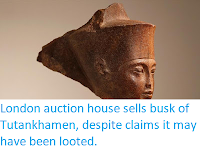The lost capital of the Egyptian New Kingdom Pharoah Amenhotep III has been discovered, according to a press release issued by the Egyptian Ministry of Antiquities and Tourism on 8 April 2021. The city, known as 'Ascension of Aton' (or 'Sunrise'), was built during the reign of Amenhotep III (roughly 1391-1353), ninth king of the eighteenth dynasty and continued in use into the reign of his grandson Tutankhamun (roughly 1342-1325 BC), although the administrative centre of the state was moved to Amarna by Amenhotep III's successor Amenhotep IV (also known as Akhenaten the Heretic).
The city was found during a search for the funerary temple of Tutankhamun, on the west bank of the Nile at Luxor, an area close to where the funerary temples of Ay and Horemheb (his immediate successors). It is the largest Ancient Egyptian city discovered to date, with distinctive administrative and industrial areas, and houses about 3 m high arranged along winding streets.
Excavations at the site began in September 2020, a few weeks after its discovery, quickly uncovering a complex of well-preserved mud-brick structures, with most of the walls still intact and many tools and other every-day artifacts left in place.
The uncovering of the city has been hailed by archaeologist Betsy Bryan of Johns Hopkins Univerisity as the most important discovery in Egypt since the discovery of Tutankhamun's tomb by Howard Carter in 1922.
The city can potentially reveal details about the everyday lives of ordinary Egyptians during the powerful Eighteenth Dynasty period, as well as the politics of the time of Amenhotep IV, who acted as co-ruler during the last eight years of the reign of Amenhotep III, began his own rule in the new city, but then moved to the new city of Amarna to rule alongside his wife Nefertiti.
A large number of artifacts in the new city, such as wine vessels, rings, scarabs, coloured pottery and mud brick, bears hieroglyphic inscriptions which link the city to Amenhotep III, which is taken as conformation the city is his capital. The area of the city excavated so far comprises three royal palaces, as well as administrative and industrial centres, and several residential neighbourhoods.
The city is surrounded by a distinctive zig-zagging wall, which is a feature almost exclusively associated with late-Eighteenth Dynasty structures. This wall is believed to have been a defensive structure, presenting only a single entrance to the interior.
Industrial sites within the city include brick factories and workshops where amulets and other metal items were crafted, as well as an extensive bakery complex. Spinning and weaving equipment has been uncovered, as well as large amounts of glassware, although a site of glass production has yet to be found.
Several Human and Animal burials have been uncovered, including a Cow and Bull, and a Human buried with arms with their arms stretched out next to them and their knees bound with rope, something not previously seen at any Egyptian site. A cemetery complex comprises tombs carved into rock in a similar way to those at the Valley of the Kings (also associated with the Eighteenth Dynasty).
See also...



Follow Sciency Thoughts on Facebook.
Follow Sciency Thoughts on Twitter.







